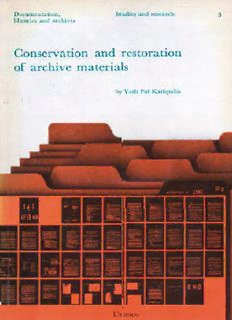
Conservation and Restoration of Archive Materials PDF
Preview Conservation and Restoration of Archive Materials
Conservation and restoration of archive materials by Yash Pal Kathpalia Unesco Paris 1973 Documentation, libraries and archives :s tudies and research 3 I i Titles in the series Unesco manuals for libraries: I. Education for librarianshi$ I. Public library extension 3. Adult education actiuitiesf or public libraries 4. Libraries in adult andf undamental education: the report of the Malmö seminar 5. Deuelopment of public libraries in Latin America: the São Paulo conference 6. Development of public libraries in Africa: the Ibadan seminar 7. Public libraries for Asia: the Delhi seminar 8. The Delhi Public Library: an eualuation report g. Public library services for children IO. The small public library building I I. National libraries, their problems and prospects: symposium on national libraries in Europe II. Thep rimary school library and its services I 3. The organization of the small public library 14. University libraries for deueloping countries 1-5 . International distribution of catalogue cards: present situation and future prospects 16. Methods of teaching librarianship I 7. The planning of library and documentation services Titles in this series : I. Study and draft of a model archiues law 2. Public library legislation: a comparatiue study 3. Conservation and restoration of archive materials Published in 1973 by the United Nations Educational, Scientific and Cultural Organization 7 Place de Fontenoy, 75700 Paris Printed by Imprimeries Populaires de Genbve ISBN 92-3-101073-5 0 Unesco 1973 Printed in Switzerland Preface The historical material held in archives forms part of the cultural heritage of mankind, and the conservation of such holdings is of vital importance. In I9 69,t herefore, Unesco concluded a contract with the International Council on Archives for a manual on the conservation and restoration of archive materials. This manual, which accords particular attention to the specific problems encountered in regions with unfavourable climatic conditions, has been prepared by Yash Pal Kathpalia, M.Sc. (Chemist), Scientific Officer at the National Archives of India, New Delhi, and is based on his own research and experience. The aim of the publication is to provide archivists and librarians responsible for manuscript collections with a survey of the methods, techniques and materials employed in the conservation and resto- ration of archive materials. The author of the present document is responsible for the choice of facts presented and their interpretation;t he opinions expressed are not necessarily those of Unesco or of the International Council on Archives. Contents List of illustrations 9 Foreword II Introduction i5 I. Constituent materials of documents 31 2. Deterioration-causes and control 48 3. Principles of repair 78 4. Cleaning, washing and flattening 86 5. Deacidification 104 6. Restoration 121 j. Special problems in the restoration of documents 141 8. Special problems concerning work rooms and restoration materials 163 g. Aids to preservation I 82 I o. Preservation of microfilms and sound recordings 193 Apflendixes I. Physical and chemical tests 2. Formulae and specifications for ink 3. Pastes 4. Leather dressings 5. Equipment for repair and binding 6. Norms of output j. Some addresses Bibliography List of illustrations Facing Page Mallet fumigation chamber (France) (Formaldehyde fumigation) 56 Vacuum fumigation chamber Thymol fumigation cabinet in use at the National Archives, New Delhi Cockroaches Damage by cockroaches White-ant worker White-ant damage Book-worm damage Water-stained and fungus-damaged document Washing on floating platforms in thermostatically heated wash basins 88 Washing in a tray containing water. Sheets interleaved with wet-strength resin-sized paper Spot bleaching with hypochlorite Drying oven with racks. Also, a view of trolley where drying racks can be placed after taking them out of the drying oven Pettifoger for humidification of folded papers Air cleaning units for cleaning documents with compressed air Pasting guard strip at the fold 128 Document after repair with solvent lamination Hennecke process. Kaschiermaschine K42 for lamination Facing Page Flat-bed hydraulic laminator Stitching on tapes or leather strips Gold tooling of bound volumes Binding unit Author imparting training in solvent lamination process Masino-Impex laminator Arbee laminator Preparing sandwich of a document prior to lamination. Barrow laminator Drying of flood-damaged volumes in tobacco barns I 60 A view of flood-damaged volumes Medium-sizer oom for equipment and machinery Repair room-Florence State Archives Records received for repair Storage of properly bound and improperly bound volumes Storage of document boxes on shelves Foreword The conservation of archive materials is a skilful art confined before the development of modern processes to a small number of institu- tions throughout the world, and utilizing methods dependent on the ingenuity and dexterity of the restorer. Although the interven- tion of science has led to a better understanding of the various causes and problems of deterioration and to the formulation of preventive measures, the use of orthodox methods and techniques has continued and is in all probability likely to continue; the processes used have withstood the test of time and proved their usefulness. They comply with the essential principles of repair, reversibility, for example, and may be easily adopted for preserva- tion work in those developing countries which have opened or are in the process of opening their own archive centres and whose interest in the development of repair activities is hampered by lack of funds, facilities and trained personnel. There is no short cut in this art and there is no school which exclusively provides training in the conservation and restoration of archive materials. The few institutions which do impart training confine their efforts to in-training for conditions and processes suitable to their own needs. Such institutions have mechanized their restoration units and are using modern preservation techniques. In 1968,t he Executive Secretary of the International Council on Archives (ICA),M i Charles Kecskemeti, returning from the inauguration in Malaysia of the South-EastA sian Regional Branch of ICA (SARBICA), paused in New Delhi to visit the National Archives. In his talks with me then, he suggested the need for a manual on the conservation and restoration of archive materials. II
